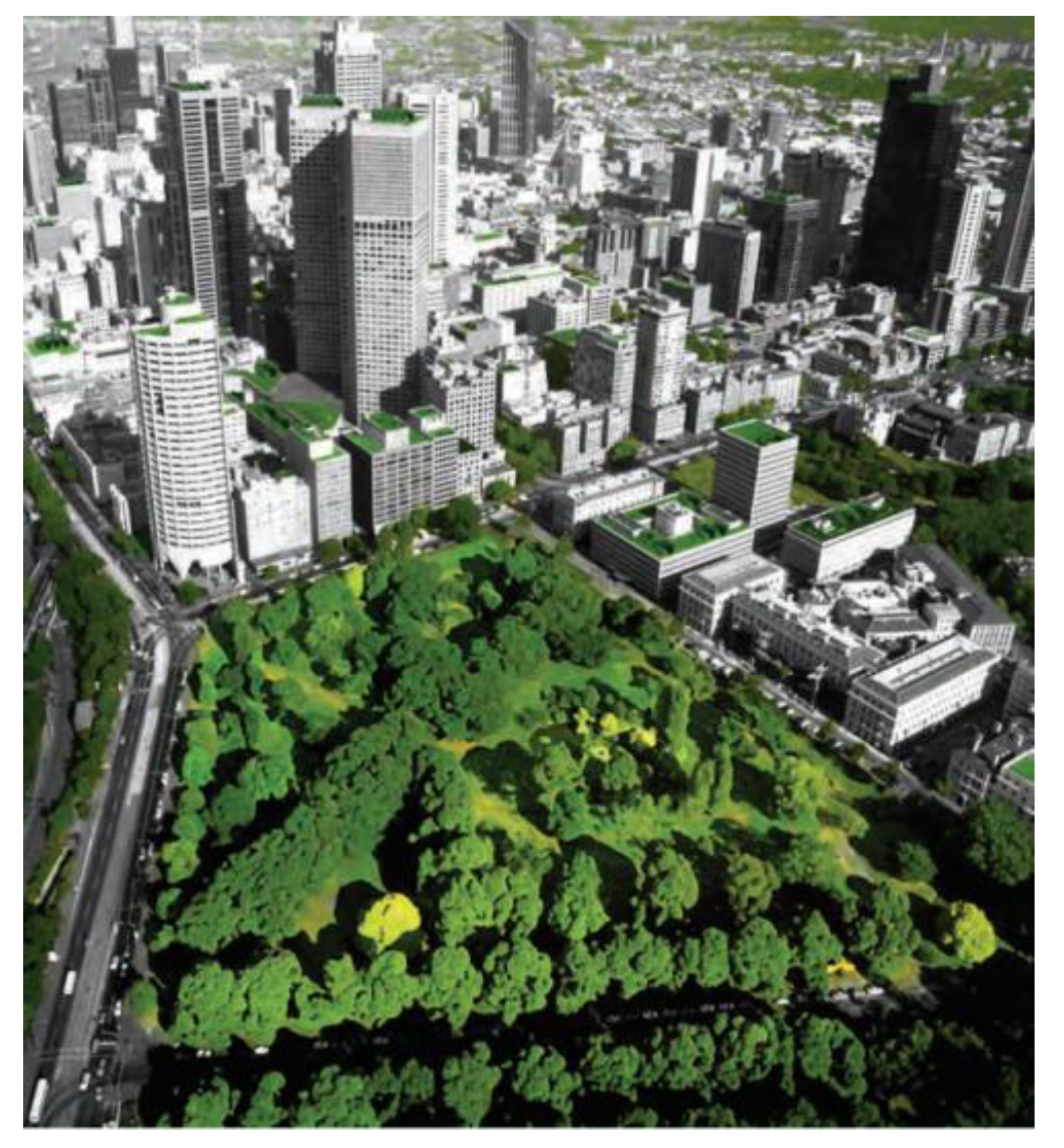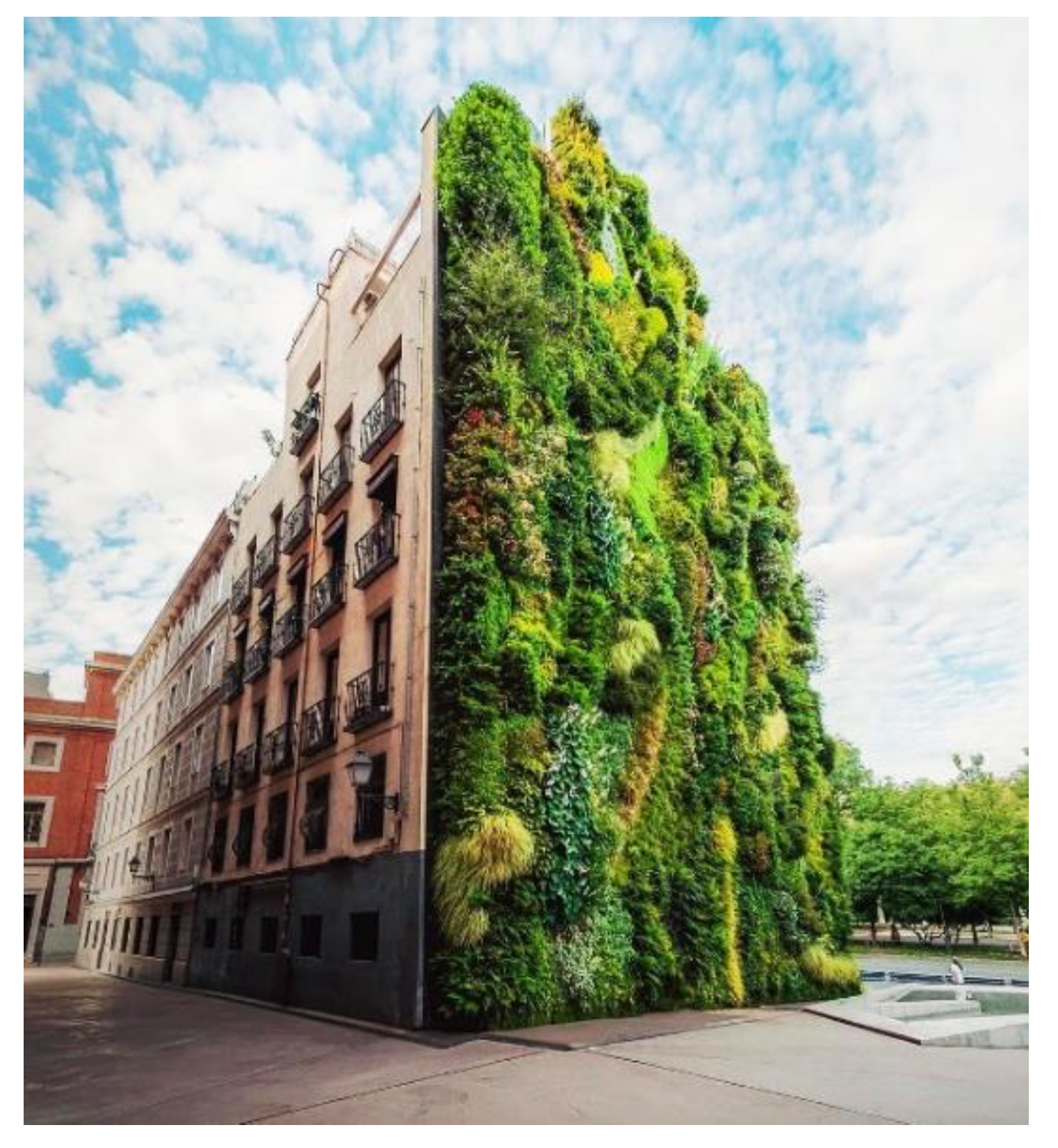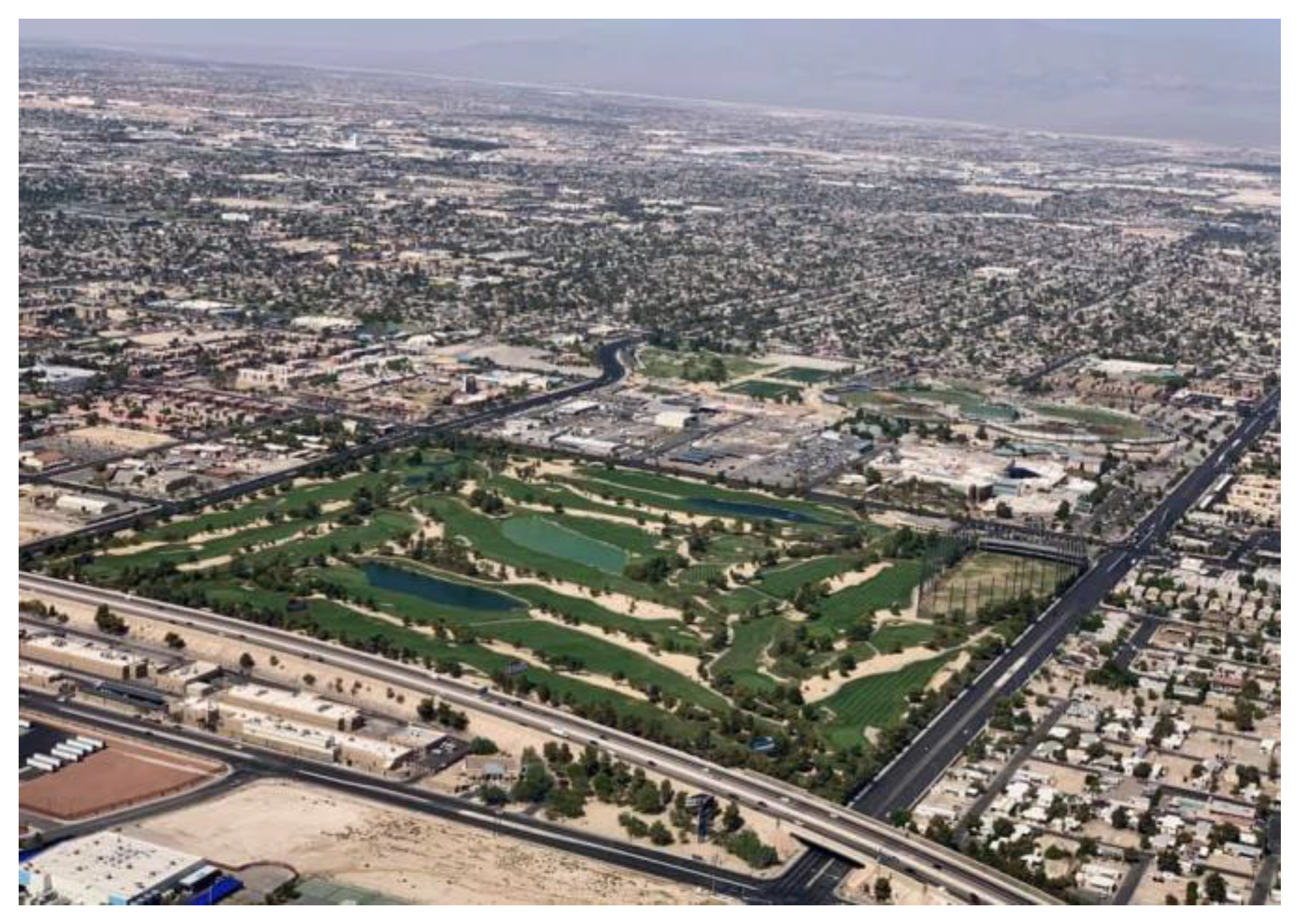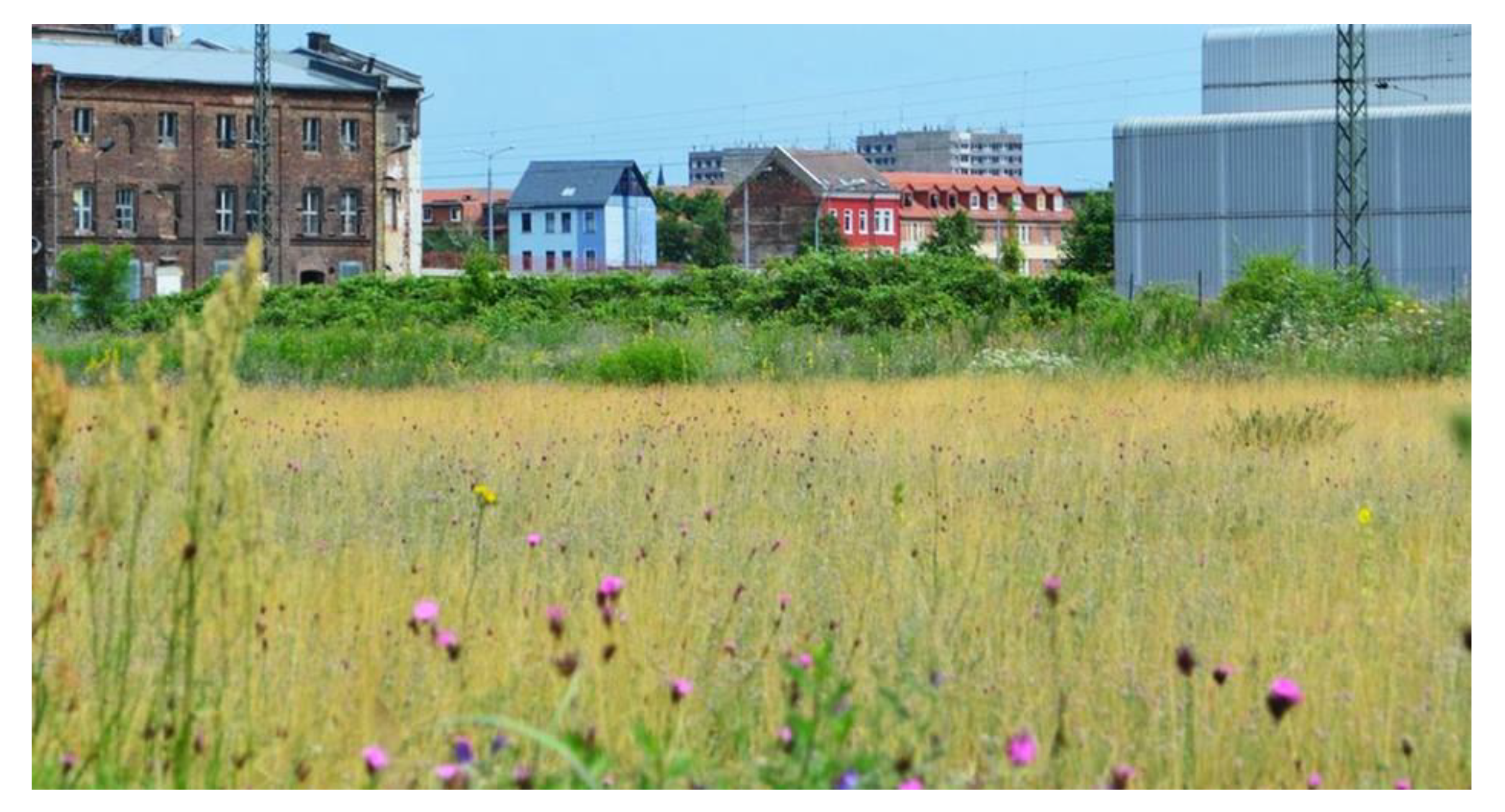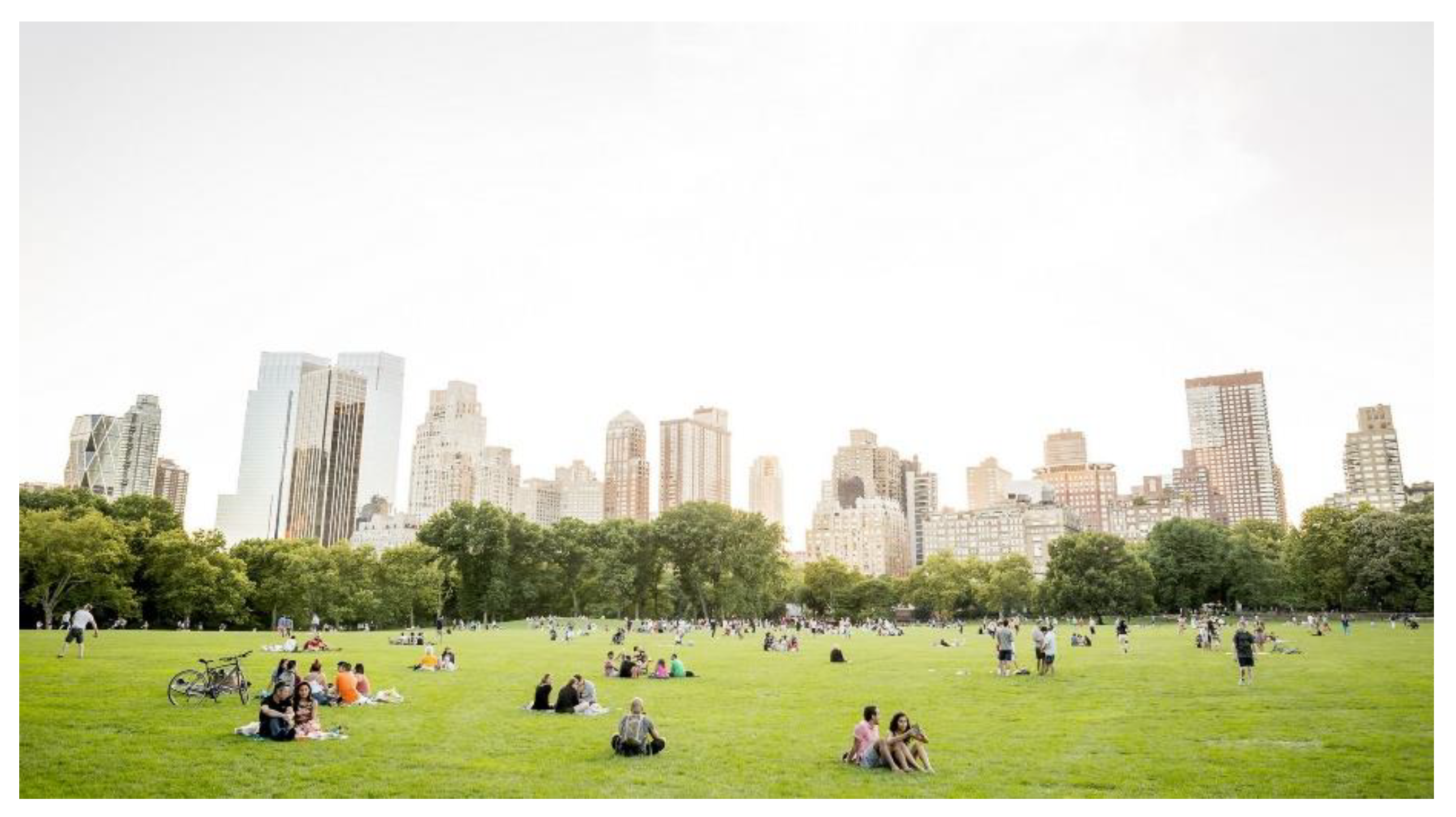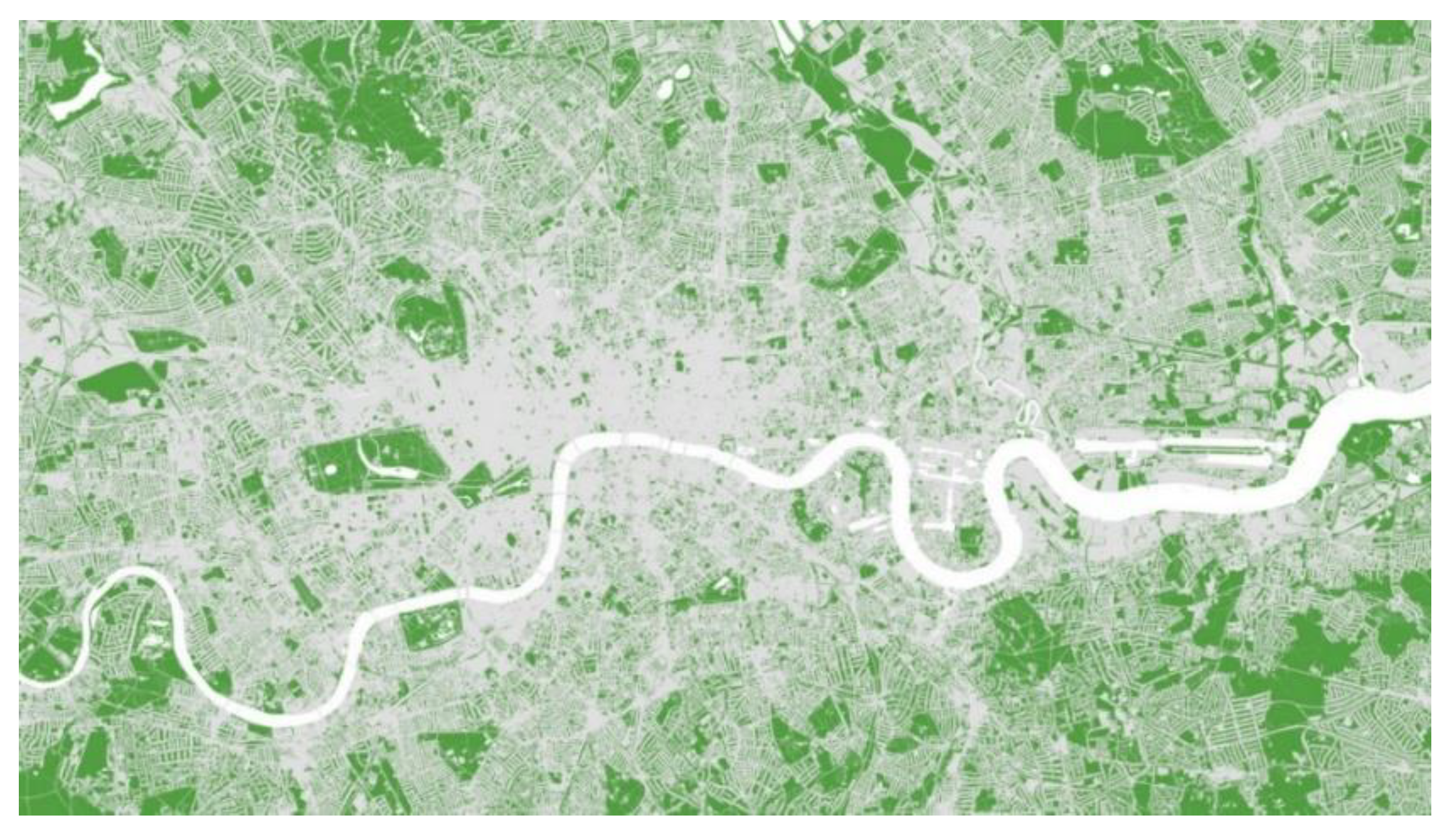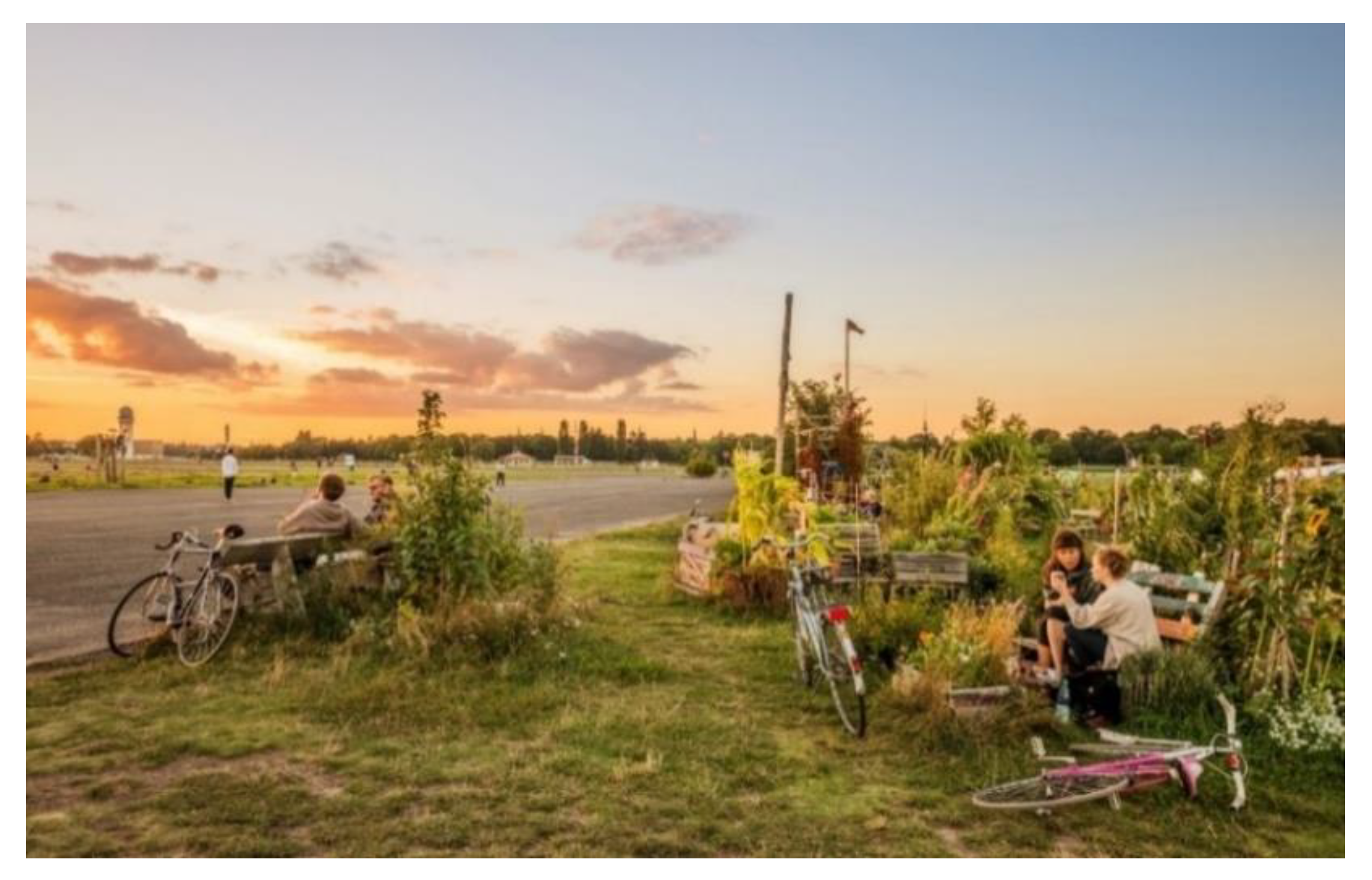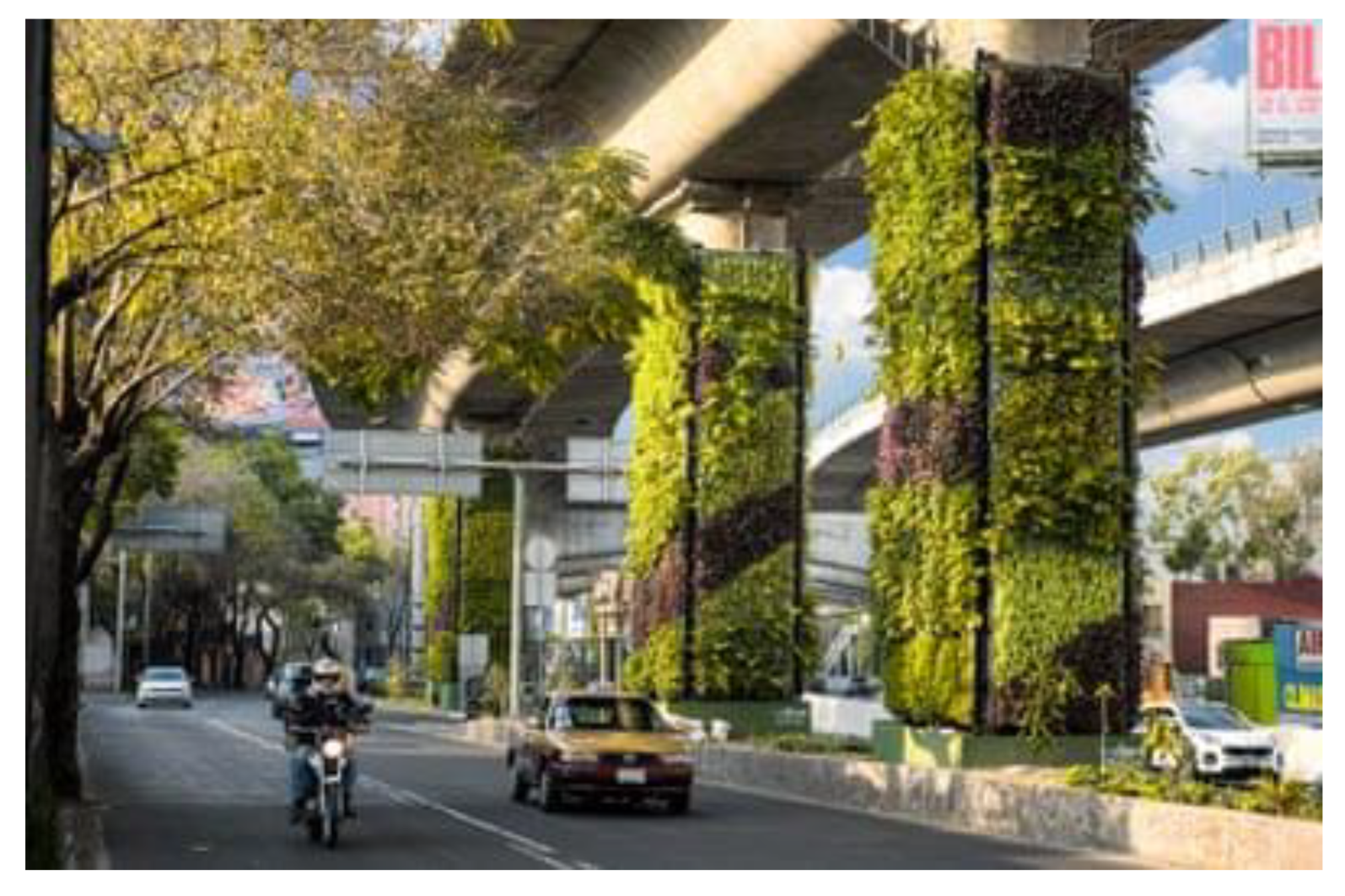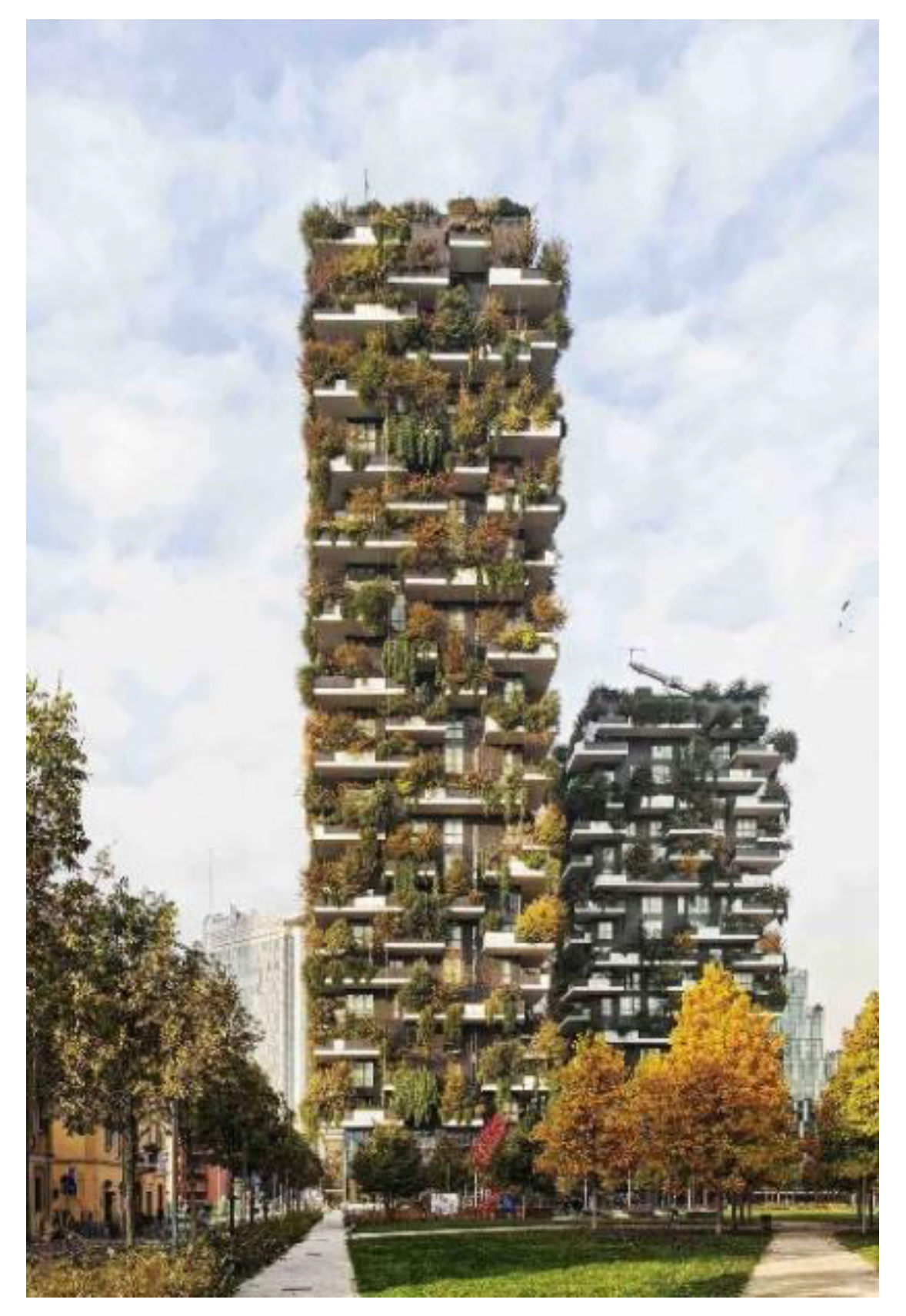1. Introduction: How Can We Stop the Decline of the Quality of Life in Cities?
Over the centuries, humanity has become a force that changes the planet, and this change has become so fundamental that it could finally overturn the Earth’s system. In 2020, scientists found that the total weight of all human-made objects had, for the first time, exceeded that of all living things (known as biomass) on planet Earth. In other words, the combined weight of all buildings, roads, plastic, bricks, concrete, and other things humans have made outweighs all animals and plants [
1].
Our current disconnect from nature has evolved over the last 300 years with the emergence of science, technical progress, and the subsequent Industrial Revolution. Within a short time, humans have experienced a transition from a life predominantly spent outside towards a vastly different life spent mostly inside buildings and in an urban context―a fundamental change in our relationship with nature has been the result. For example, more than 80% of the US population currently lives in urban areas, with a substantial proportion being “estranged from nature” [
2]. Today, we spend 90% of our lives indoors, in controlled interior environments [
3], with an increasing amount of time spent on “screen time” online alone.
Cities are also centers of consumption: 75% of our natural resources are consumed in and by cities, while cities are responsible for 50% of the world’s waste and emit 60 to 80% of global greenhouse gas emissions. Moreover, by 2050, metropolises must solve the challenge of accommodating more residents, offering a higher quality of life, and buffering the consequences of climate change. This is a considerable challenge. At the same time, urban ecosystems are under stress, as they must withstand more frequent and longer dry periods, with increasing heat, air pollution, and water shortages [
4].
Over recent years, the quality of life in many cities has declined. Reasons for this decline include air pollution, ever-increasing traffic—mostly private cars—and housing that has become unaffordable. Therefore, we must plan ahead better, including for the further increase in urban populations, so that we will not lose the livability of our cities we currently enjoy.
We face an array of societal challenges, which in the past we have tried to solve in ways that were not always successful. This has led to urban sprawl, worldwide biodiversity loss, a climate crisis, increased inequality, and global human vulnerability. Furthermore, evidence shows that an urbanization model resulting in urban sprawl is wasteful in terms of land use, energy use, and other resources―including wasted time, which would be better spent with family rather than being stuck in traffic. Urban sprawl plagues cities in both developing and industrialized countries. A study by UN-Habitat has shown that since 2000, urban densities worldwide are in decline, a result of rampant land consumption [
5]. In the United States, for example, land development has quadrupled since 1945, growing at twice the rate of population growth. In addition, evidence from research shows that sprawl has a negative social impact, leading to more isolation, loneliness, and cases of depression and obesity [
6,
7,
8,
9,
10].
Every city is unique. Cities differ not only in their size and density and in the distribution of their population and green spaces but also in their climatic and cultural contexts, geography, and in the ways in which they are vulnerable to climate change. When it comes to enhancing urban resilience through applying nature-based solutions (NBS) and regreening strategies, what works in one city may not work in another. However, urban regreening projects generally allow for “repairing” and restoring some of the damage caused to ecosystems while enhancing urban resilience.
Good urban design and planning can make a profound positive contribution to solving the problems related to climate change and societal challenges. Transforming the practice of planning and architecture must lead to the delivery of coherent and robust urban design, and not just architectural objects. Combined with strategies for gentle densification, different urban infill scenarios, and the integration of NBS, urban transformation and regeneration will need to be simultaneously dense and green. As numerous projects have shown, this is not a contradiction—we can have both: dense and green combined.
1.1. Methodology and Purpose of This Review Article and Methodology
The purpose of this review paper is based on a literature review in the area of regreening of cities and attempts to make a relevant contribution to the regreening and renaturalization of cities debate. Using qualitative research, the objective is to assess the qualitative themes presented in the literature and the relationships between the various strategies and conceptual models to facilitate cross-disciplinary design optimization.
1.2. Working Definitions
The following part provides short working definitions of the terms nature-based solutions, urban resilience, the urban heat island effect, and urban greening.
The term nature-based solutions (NBS) refers to the use of nature for addressing environmental, cultural, and societal challenges while increasing biodiversity and balancing urban temperatures of the city cores. According to IUCN [
11], NBS are “actions to protect, sustainably manage and restore natural or modified ecosystems that address societal challenges effectively and adaptively, simultaneously providing human well-being and biodiversity benefits”. Nature-based solutions for public and urban spaces play a key role in urban regeneration and improving well-being in urban areas. The solutions include measures such as green roofs, green walls and screens, and sustainable drainage systems. A green wall is a term that encompasses all forms of vegetated wall surfaces, whereas green screens consist of steel or plastic mesh on which climber vegetation grows.
Urban greening refers to the process of establishing the components of green infrastructure and plants within the built environment. There is growing appreciation that regreening cities helps to provide viable solutions using and exploiting the properties of natural ecosystems and the services they provide. Municipalities are now looking at how urban areas can adapt their landscapes to better manage the increasing heat stress and to build adaptive capacity. Ecosystem services delivered by city vegetation through healthy street trees, tree-lined avenues, gardens, parks, wetlands, urban forests, green roofs, and living walls are now becoming more appreciated and part of urban master planning. Recent modeling studies by researchers at the University of Surrey found that green roofs could result in a reduction in air pollution of up to 30 to 57%.
Rewilding activities are ecological restoration and conservation efforts aimed at restoring and protecting natural processes and wilderness areas by restoring an area of land to its natural uncultivated and self-regulated state. The term is used especially with reference to the reintroduction of species of wild animals, insects, birds, and flora and fauna that have been driven out or exterminated. Rewilding has significant potential to increase biodiversity, create self-sustainable environments, and mitigate climate change. Passive rewilding aims to reduce human intervention in ecosystems, giving human-cultivated land back to nature and restoring nature.
The urban resilience of cities refers to cities’ ability to maintain human and ecosystem functions simultaneously over the long term, even during a disaster or crisis, and the capacity to deal with sudden change and continue to develop [
12]. Similarly, urban resilience, also called adaptive capacity, refers to a city’s ability to cope with and recover quickly from hardship or crisis. A resilient city is typically one that is prepared and well equipped to contend with and mitigate the multiple effects of climate change, such as heatwaves, urban flooding, energy blackouts, and other potential disasters. A resilient city has a robust infrastructural system and can turn even a crisis into a positive development [
13,
14,
15].
The dangerous urban heat island (UHI) effect leads to significantly warmer urban areas compared to surrounding suburban or rural areas, and this temperature difference is usually larger at night than during the day. The UHI effect occurs because the dark surfaces (e.g., black asphalt on roads and concrete on building roofs) absorb and store heat during the day and then release it at night. The main cause of the UHI effect is the modification of land surfaces and material, for instance, concrete roofs that store and trap solar radiation heat during the day. Urban greenery can help reduce this heat gain and the negative impact on human health [
16,
17]. Therefore, green roofs and facades can best counteract it with plants and vegetation, white or light-colored surfaces (using the albedo effect to reflect solar radiation), and the use of materials that absorb and store less heat.
1.3. Learning from Crisis: The Post-COVID-19 City Will Need to Be Green
The recent COVID-19 pandemic has led to an acceleration of previously observable trends such as using home offices, designing buildings with natural ventilation, and reconsidering mobility. It also brought the value of direct access to a small green space or roof garden to the forefront. However, the issue is not urban density but systemic economic inequality that forces lower-income people to live in overcrowded conditions. Overcrowding in apartments, at restaurants, and at events, rather than urban density per se, leads to the spread of the virus (Daugherty, 2020).
Post-pandemic, it is likely that cities will see an end to the trend towards micro-apartments without balconies, a view, or access to a garden. The pandemic forced us to reconsider housing, as it can make a significant difference when the window is in the right place to catch sunshine and offer a street view, or when there is access to a small roof garden. These are basic user concerns that architects have neglected for too long. Green buildings with natural cross-ventilation, such as courtyard typologies, are not only good for our health but also enable us to perform better and be more productive. A recent WHO report (2014) refers to the need for sufficient green spaces in all cities and defines a healthy city:
A healthy city is one that continually creates and improves its physical and social environments and expands the community resources that enable people to mutually support each other in performing all the functions of life and developing to their maximum potential [
18].
This approach puts health high on the political and social agenda of urban planning and drives a strong movement for public health at the local level as a key driver of all urban development.
The concept of biophilia, introduced by Edward O. Wilson [
19], suggests that humans possess an innate tendency to seek connections with nature and other forms of life [
20]. As already predicted by Rachel Carson in
Silent Spring in 1962, we are now in the process of redefining our relationship with nature and realizing how our health depends upon it. This growing understanding is not about giving up technology but rather about developing the most advanced technologies and NBS to date, for instance, through the biological revolution, digital fabrication, and nanotechnology. We have to use that rich and available knowledge to find innovative and improved solutions for cities, employing ideas of biomimicry—innovation inspired by natural systems [
21,
22].
Biophilic urbanism uses the calming and cooling effect of nature as a tool in urban planning. It is about new ways to combine density with greenery to enhance urban resilience. The strategy is to have more urban greenery and higher densities at the same time (as was recently realized successfully in projects in Singapore, Milan, and Barcelona). Dense and green does not have to be a contradiction: it is about increasing urban density while at the same time increasing the amount of accessible green space, and integrating urban greenery in new ways, including urban food production and farming on roofs of large buildings. Thus, increasing urban density must mean more green spaces and the integration of vegetation into the urban fabric.
1.4. From Howard’s Garden Cities, to McHarg’s Environmental Manifesto, to Biophilic Urbanism: A Short Review of Literature on Regreening Cities
As far back as in the 1722 book
The City Gardener, the English botanist Thomas Fairchild (1667–1729) noted that “city residents feel more relaxed and healthy when they can enjoy gardens and greenery” [
23]. From René Descartes (1637) to Thomas Fairchild, Ebenezer Howard, Ian McHarg, and Dennis Meadows et al. [
24,
25,
26,
27], there are direct linkages that exist between a rich palette of seminal literature and different schools of thought about the possible role of NBS within the city. Fields, orchards, gardens, meadows, and fishponds right alongside their largest and most significant building, the church or cathedral, traditionally penetrated the great cities of the past. Ebenezer Howard’s vision of the garden city movement (published in 1902) proved to be enormously influential in city planning circles throughout the world. From garden cities to biophilia, reconnecting cities with nature means enhancing resilience at the urban scale, and there is growing recognition of the need for daily contact with nature and green spaces to live happy, productive, and meaningful lives.
The seminal publication
Design with Nature (Ian McHarg, 1969) [
26] was the first environmental manifesto to explore green spaces in cities and to examine how the ethos of designing with nature has evolved over the 20th century. With the threat of climate change, species extinction, and major resource depletion, McHarg addressed the need for broader coordination, longer-term strategies, and clarity of policy, leadership, and action [
28]. The 1972 report
The Limits to Growth [
27] was immensely important in the way it challenged the common thinking of the time about land consumption, finite resources, and the concept of endless growth. Shortly after, it was followed by James Lovelock’s pivotal book
Gaia: A New Look at Life on Earth (1979) [
29].
Today, cities can possess degrading conditions―just think of windowless work environments, overcrowded housing, air pollution, noise, and the lack of any trees on the street (Lehmann, 2020). Cities are not obvious places to reconnect with the natural environment. Cronon (1995) asserted that urban inhabitants have created a wholly artificial view of what nature and wilderness are, based on ideas of open space and grandeur that rarely correspond to the lived reality of the people who inhabit suburban or rural spaces. The view of nature as a pristine and uninhabited space makes it difficult to see nature on a smaller, less imposing scale and to appreciate, for instance, that a tree in an urban back garden can equate to a tree growing in a forest—that the two trees are identical despite the different settings. In our minds, the forest tree somehow has a greater perceived natural value, and nature is seen as being something that does not necessarily belong within the city [
30].
Urban planners’ worldwide aim is to bring nature back into the city in all kinds of ways to compensate for the lack of parks, gardens, and green spaces. The concept of urban metabolism understands cities as vulnerable living organisms. Urban metabolism analyzes the flows of energy, resources, food, people, and waste or materials in cities as if the city were a living ecosystem and provides a framework for the study of the interactions of natural and human systems using the metaphor of the city as a living organism. Ecologist Arthur George Tansley (1871–1955) expanded the term to encompass the material and energetic streams [
31]. Influential texts by various authors offer further ecological wisdom on the planner’s relationship with nature and landscapes and their ecosystems [
32,
33,
34,
35,
36,
37].
Today, in the United States, more than 50% of the population lives in suburbs of dispersed, car-dependent cities. In cities such as Houston, Dallas, Phoenix, and Las Vegas, this figure is even closer to 80%. San Diego in Southern California is a classic example of a sprawling metropolis with mile after mile of scattered low-density car-dependent development, and it is suitably called the 200-Mile City. Urban sprawl means excessive land consumption. In Germany alone, more than 100 square kilometers of greenfield land is sealed every year, built on or paved over. Consequently, the rainwater can no longer seep away to join the groundwater, often leading to urban flooding after heavy rainfall. The days of heavy rainfall are 85% more common in Europe today than they were a hundred years ago, and scientists predict that this trend will only continue until 2100.
In the 1970s, Portland, Oregon, offered a pioneering solution with the creation of a strict urban growth boundary to protect the surrounding agricultural land from ever-increasing sprawl. At the same time, Portland invested heavily in public transport such as a light-railway system connecting the suburbs with downtown. These strong urban planning requirements, adopted almost five decades ago, have led to urban containment and a more compact city form. The growth boundary has ensured that the city grew inwards and became compact rather than increasing its footprint. Consequently, for the last 30 years, a renaissance of the urban core has been underway that is making a dense urban lifestyle more practical. It made Portland one of the most walkable and livable cities in the entire United States, and the trade-off of preserving as much natural habitat around the city as possible resulted in greater regional biodiversity.
Planners and architects have long advocated for increased density and walkable, compact, mixed-use, transit-oriented development, combined with greening strategies, to improve city residents’ life, combat sprawl, and mitigate climate change. There are four key strategies that have emerged:
- (1)
Halting building on greenfield sites and into the surrounding landscape by establishing a strict urban growth boundary.
- (2)
Renaturing the city so that the landscape is allowed back into the city, and not the other way around. Instead of the city eating into precious landscape, landscape fingers can extend into the city.
- (3)
Applying NBS, including planting urban forests, which has been shown to be beneficial (e.g., in Melbourne, Australia; see
Figure 1), as it keeps cities cooler during heatwaves and sequesters CO
2 emissions.
- (4)
Promoting green roofs and living walls, which have become a popular feature in architecture worldwide (see
Figure 2).
Green roofs and plants reduce the heat load and clean the air, which allows for more natural cross-ventilation and smaller air-conditioning plants. More and more green roofs are now designed with native plants and with productivity and water saving in mind.
A large group of researchers discussed the psychological health benefits of nature in urban spaces based on environmental psychology theory on nature contact. Kaplan and Kaplan (1989), in “The experience of nature”, describe how office workers with a view of nature were happier and healthier at work, and how generally exposure to natural environments has been proven to lift people’s moods and enhance their ability to mentally focus. Ulrich (1991; 1993) suggests that looking at nature is beneficial to our brain and introduces stress reduction theory (SRT) to explain emotional and physiological reactions to natural spaces.
Architect Ken Yeang has been a pioneer in bioclimatic design, embracing passive systems and strategies to reconnect to the natural environment, which he says is the key to sustainable design. The text “Ken Yeang: A Theory of Ecological Design” (2006) presents four eco-infrastructures, namely:
- (1)
People, society, and culture.
- (2)
Nature’s utilities.
- (3)
Water.
- (4)
Building utilities; a model that could be expanded to connect with the urban landscape and regreening in urban regeneration projects.
In this context, it is beneficial to examine the various websites created around Horizon2020 research projects on NBS; i.e., Nature4Cities (
https://www.nature4cities.eu, accessed on 25 November 2020), Naturvation (
https://naturvation.eu/, accessed on 25 November 2020), and CLEVER Cities (
https://clevercities.eu/, accessed on 25 November 2020). These propose numerous examples for NBS described from the technical point of view and from the implementation point of view, which is frequently the real challenge for NBS. The European Commission recently published a report entitled “Nature-based Solutions–State of the Art in EU-funded Projects” (2020) that gives a comprehensive summary of research on a wide range of aspects concerning NBS design and implementation.
Natural landscapes in cities have become limited, degraded, and replaced with impermeable hard surfaces, such as roads, paving, and car parks; however, the reversal of this trend is dynamic, complex, and still in its infancy (Xing, Jones and Donnison, 2017). The research article “Characterisation of Nature-Based Solutions for the Built Environment” by Xing, Jones and Donnison provides a useful foundation for a deeper discussion on NBS, and outlines:
- (1)
A generic characterization framework for exploring nature-based built environment solutions.
- (2)
Potential multiple benefits of nature-based solutions.
- (3)
The key benefits and measurement examples for green infrastructures.
- (4)
A simplified typology of nature-based urban actions.
In recent years, numerous frameworks have been developed to address the global challenge of developing a safe, healthy, inclusive, equitable, efficient, and resilient built environment. LEED v4. for Cities and Communities is a rating system for evaluating the sustainability in a city, created by the US Green Building Council. It was released in 2019 and it addresses environmental, social, and economic aspects of a city with a clear, data-driven means of benchmarking and communicating progress.
2. Discussion: Excessive Heatwaves and Fast-Warming Cities
The recent IPCC report and numerous other research studies confirm that more plants, trees, vegetation, and greenery in the city will reduce the heat load, or the UHI effect, as large-leaf trees bind the dust, clean the air, and reduce the size required for air-conditioning plants [
38,
39,
40,
41,
42]. Therefore, many cities have started to question the outdated 20th-century concept of infinite urban growth and are now searching for new ways to enable more compact inner city living on a reduced area of land per capita that does not trigger gentrification.
Understandably, there is now a revival of the 19th-century pre-automobile, compact, six-story European city model (a model that can be found in Berlin, Paris, Milan, Barcelona, Athens, Stockholm, and numerous other cities), as it has shown to be the most energy efficient and resourceful of all urban models. It creates a reasonable population density (at around 80+ residential units per acre) and does not waste valuable land. It does not generate unnecessary traffic or waste energy, but offers the following:
Quiet green courtyards, which allow for natural cross-ventilation.
A diversity of public spaces, squares, and streets as places for regreening.
Five- and six-story mixed-use urban blocks that share walls and circulation.
The compact walkable European city model is the most sustainable way of urbanization, as it means the lowest use of land and resources.
It is well documented that 20th-century urban planning and zoning has made cities more car dependent and has led to adverse and unequal local environmental and economic conditions within urbanized regions. Intentional planning with a concern for integrated green spaces has the potential to dissolve longstanding environmental and economic inequities. There is also growing evidence that urban landscapes affect rural landscapes, and vice versa—particularly at the urban–rural interface.
This is especially relevant across Asia and the American Southwest, which is seeing rapid and large-scale transitions of landscapes, including from farmland, forests, and desert to residential and car-based infrastructure. The urban areas of Las Vegas, Phoenix, Tucson, Albuquerque, and El Paso are the nation’s fastest-warming cities with the most extreme UHI effect. In this region, large parking lots store excessive heat and are significant UHIs. Design firm Studio NAB has developed a conceptual proposal of how a large, big-box parking lot could be reimagined as an urban farm, with some space for charging electric cars from on-site solar panels (see
Figure 3 and
Figure 4).
Greenhouses and fruit trees grow produce that can be supplied directly to the neighboring store—like the model used by the urban farming company Gotham Greens, which grows produce in a greenhouse on top of a Whole Foods rooftop in New York. Some parking spaces remain, where the asphalt is replaced by green space that can help sequester CO2 and absorb rainwater. Urban communities have not typically been associated with food production, which is associated mainly with rural spaces. Through significant technological advances (e.g., robotic farming using hydroponics), urban agriculture could possibly meet up to 10% of the entire food demand of urban communities and make meaningful contributions to food security, public health, and urban sustainability and resilience.
Causes for the Urban Heat Island Effect
Cities in southern Europe, for example, are expected to experience up to twenty additional “hot” days every year from 2050 onward. While many coastal cities used to be cooled by the sea in the daytime, the regulatory effect of the sea is reversed at night with coastal areas reporting higher temperatures, eliminating the cooling sea breezes. As a consequence, one of the most pressing issues facing cities is the urban heat island (UHI) effect: a self-perpetuating problem with dangerous consequences. The term UHI is used to describe an urban area that is warmer than the rural areas that surround it; a local-scale temperature difference, where the increased temperature is over 5 degrees Celsius higher. Urban temperature increases are expected to accompany future population growth, putting more people in danger from the negative health effects of extreme heat. Those particularly vulnerable to heat-related problems include young children, older adults, outdoor workers, and low-income populations.
The main causes of the UHI effect are urban development, the loss of green space and building materials that absorb heat rather than reflect it. Heat-trapping materials cause a rise in ambient temperature, and this additional heat can bring a number of other harmful consequences. Impermeable surfaces that stretch across cities, such as black asphalt and rooftops, absorb the heat. Light-colored and permeable materials can successfully reflect heat and remain cool. These light-colored materials and coatings deflect heat rather than absorb it, taking advantage of the albedo effect.
Other contributing factors include heat pockets between tall buildings, waste heat caused by transport, and the self-perpetuating problem of air conditioners: as cities get hotter, residents require more air-conditioning, which in turn produces waste heat that further contributes to the problem, driving up energy consumption and greenhouse gas emissions. Air-conditioning consumes a great deal of electricity and creates more heat in the process of cooling an area down. Increased emissions can lower air quality, which also affects public health. Power disruptions and blackouts during heatwaves can overload power grids and cause infrastructure to malfunction, putting public health and safety at risk.
Increased air pollution is another symptom of the urban heat island effect leading to a variety of harmful conditions. Poor air quality causes breathing problems thanks to fine particulate matter, and accelerate the formation of ground-level ozone. Rising temperatures can also harm water quality, as minor temperature changes have frequently a devastating impact on aquatic life. When the warmer water drains into sewers, it subsequently flows into natural bodies of water, upsetting the natural ecosystems and accelerating the growth of bacteria.
3. Principles for the Integration of NBS into Urban Planning: The Positive Impacts on Land, Water, Air, Urban Heat, Biodiversity, Health, and Well-Being
Rewilding areas in cities has become a powerful strategy to bring back butterflies, insects, birds, and wildlife. In contrast to highly managed parks and gardens, these rewilding initiatives are leaving allotted spaces mostly uncultivated and self-regulated. Biodiversity blooms in cities where manicured green spaces were once allowed to proliferate as native grasses, shrubs, and wildflowers attract more animals that are diverse, with a diverse flora and fauna, over time. Research has shown that when self-regulating meadows and areas of biodiversity replace maintenance-heavy monoculture, these urban wilds also become more drought resistant and sequester more CO2. It is a shift away from a centuries-long tradition of managing and controlling public green spaces and using pesticides.
Rewilding initiatives can be focused on smaller areas of existing parks. Early urban rewilding initiatives were the Mauerpark in Berlin-Kreuzberg and the High Line in New York City, a once-abandoned elevated railway that went wild over decades before being adapted into a blossoming public park. The German city of Dessau bought up enough unused properties, brownfield sites, and inner-city land to create a 120-hectare public green zone to return to nature. In addition, the grounds of existing housing estates became part of a rewilding project; making them more attractive and improving the lives of the residents (see
Figure 5).
Scientists are now closely examining all relevant issues for the design of NBS, such as impacts on land, water, air, urban heat, biodiversity, recreation, and health and well-being. Evidence shows that NBS can generate considerable improvements in the transformation and revitalization of cities. NBS are simultaneously addressing environmental and societal challenges while increasing biodiversity. In addition, NBS help to keep cities cool, reduce the heat load, bind dust, and manage stormwater, runoff, support the healthy city agenda, and deliver positive impacts from ecosystem services provided by nature within the city. Researchers are working to identify the most impactful principles for the integration of NBS at the urban planning level (e.g., using sustainable drainage systems and bio-filtration swales) and looking at new forms of urban greenery in regeneration projects and the protection and expansion of existing green spaces as a key component in regreening cities [
43,
44].
A definition of NBS offered by the European Commission in 2017, which has been funding critical research in NBS over the last decade, states the following:
These solutions are “inspired and supported by nature, which are cost-effective, simultaneously provide environmental, social and economic benefits and help build resilience (…) and bring more, and more diverse, nature and natural features and processes into cities, landscapes and seascapes, through locally adapted, resource-efficient and systemic interventions” [
45].
Thus, NBS provide practical, sustainable, cost-effective, and adaptive alternatives for various urban planning objectives by working with nature, rather than against it. With NBS, it becomes possible to take further steps towards a more competitive, resource-efficient, and greener economy (often termed green growth). It can also help to enhance rather than deplete natural capital. For instance, green roofs and living walls can be used to reduce the impact of high temperatures, collect stormwater, reduce pollution and fine dust, and act as carbon sinks, all while simultaneously enhancing biodiversity [
46,
47,
48,
49].
Similarly, the collection and storage of rainwater in constructed wetlands and the protection of mangrove forests along coastlines employ NBS to achieve several objectives, including disaster-risk reduction and halting species extinction. Urban flood control is regulated in a natural way, with mangroves alleviating the impact of wind and waves on coastal settlements or cities while also capturing CO
2. Additionally, the mangrove forests can provide safe nurseries for marine life and help control coastal erosion resulting from a rise in sea levels, mitigating potentially harmful effects on the environment and on human health and society [
50,
51,
52,
53,
54].
Such new urban design concepts incorporate and reintroduce greenery and biodiversity into the urban built environment, subsequently leading to new models of urbanization. However, it is essential that the design of NBS is integrated with other complementary planning interventions and seeks synergies across all sectors. Maintaining biodiversity in the face of urbanization and slowing down habitat loss, habitat fragmentation, and environmental deterioration are some of the extreme challenges of the present day. The inclusion of trees, shrubs, and other plant matter into urban green spaces and gardens and onto roofs is of paramount importance in helping to keep the urban landscape cool, mitigating the effects of buildings and pavements which increase heat absorption, heat storage, and the UHI effect [
55,
56].
The regeneration of abandoned and neglected urban areas can be achieved through the restoration of damaged ecosystems: urban regeneration projects allow us to repair and restore some of the damage while enhancing walkability and urban resilience. For instance, increasing connectivity between existing and enhanced ecosystems as well as restoring them within cities and at the peri-urban fringe through the use of NBS and the renaturing of neighborhoods is necessary to strengthen resilience and the adaptive capacity of cities to better cope with the effects of climate change. Nevertheless, it is not as simple as the more trees one has in an urban space, the better the air quality will be. Some trees are markedly more effective at filtering pollutants from the air than others. For effective renaturing, it is important to explore which tree species is doing the best job; for example, conifers offer highly effective particulate matter (PM) reduction because they are an evergreen species. It also depends on canopy size, leaf size, and leaf structure.
A well-documented example for the cooling effect of an inner-city park is New York City’s Central Park, located between the Upper West and Upper East sides of Manhattan. It is the fifth-largest park in the city by area, covering more than 840 acres (340 hectares). It is the most visited urban park in the United States, with an estimated 38 million visitors annually. Central Park was created between 1857 and 1876 by landscape architects Frederick Law Olmsted and Calvert Vaux, who included ponds, bodies of water, and groves.
Often described as the lungs of New York City, Central Park’s size and cultural position have made it a model for the world’s urban parks. Between 2015 and 2018, the park’s drives were closed to vehicular traffic. The real estate value of the surrounding land had started rising significantly already in the mid-1860s during the park’s construction, and—though most of the city’s rich formerly lived in mansions—many of the wealthy citizens of New York City moved into apartments close to Central Park during the late 19th and early 20th centuries. It is estimated that Central Park has resulted in billions of dollars in economic impact and increased the value of surrounding real estate. About 600,000 people live within a ten-minute walk (a maximum of about 800 m distance) of the park’s boundaries (see
Figure 6).
4. Regenerating Neighborhoods and Bringing Nature Back into the City: The Case for Tree Planting and the Rewilding of Urban Spaces
As most of our cities keep growing and warming, the scale of the issue is significant. For example, in 2020, cities in the European Union were home to more than 70% of Europe’s population, and this figure is expected to increase to over 80% by the middle of the century. This translates to 36 million new urban citizens in Europe by 2050 alone, who will need a basic supply of housing, employment, healthcare, and access to a diversity of green spaces [
57].
With more and more people living in urban areas, the need to create and enhance green spaces around and within cities has never been greater. Some large cities, such as Brussels and Bangkok, have far too little green space within their urban areas. Bangkok, for example, has one of the lowest levels of public green spaces per capita of cities in Asia. It is no coincidence that the Thai capital city frequently struggles with urban flooding: after heavy rain, stormwater cannot drain, and there are no green spaces to slow down, store, and reduce the water runoff. Centenary Park is the first new public park project in Bangkok in 30 years, and it will add a new 11-acre green space. In future, cities will need more of such pockets of cooling and water storage.
The International Energy Agency estimated in 2018 that—with increasing urban heat—air conditioning would be one of the biggest drivers of electricity demand worldwide over the next 30 years, which has significant implications for carbon emissions unless cooling systems become more efficient. Global demand for cooling is projected to overtake heating demand for the first time in 2070 [
58].
As climate change brings higher temperatures and unpredictable downpours, cities are expecting a new kind of resilience from their urban green spaces and trees. There are numerous tree-planting programs on the way. In the European Union, three billion new trees will be planted across the 27 member states by 2030, many in and around cities. Some European politicians have become influential advocates for prioritizing nature restoration as part of the EU Biodiversity Strategy for 2030:
Bringing Back Nature [
59]. Ambitious greening projects are also on the way in several megacities, including New York City, which planted a million trees between 2007 and 2015. London hopes to green more than half the city by 2050 to make the world’s first “national park city”, while Paris recently announced that it is creating four inner-city urban forests in 2020 (see
Figure 7).
An enormous number of studies have been published on the potential impact of additional urban vegetation on urban temperature, thermal comfort, pollution reduction, and health. For example, Wright [
60] and Johns [
61] wrote about the resistance and barriers to green infrastructure. Lennon [
62] and Mell [
63] assessed the future of green infrastructure and the policy gaps that remain in the current planning legislation, while Roe and Mell [
64] evaluated the monetary value that green infrastructure can add. While usually lacking a scientific quantification of the benefits and impacts, most of the studies conclude that urban greenery offers numerous benefits.
However, the potential problems arising from the deployment of additional greenery in cities is usually overlooked. Urban trees contribute to considerably decreasing the concentration of harmful pollutants, but they may increase the concentration of some others, for example, ground-level ozone [
44]. While planting trees in urban spaces is an effective and efficient way to adapt to climate change, it is not a holistic solution [
65]. Furthermore, trees are not always seen as a benefit, and street trees in the city are in a constant struggle for water and space.
To reap the benefits of urban treescapes, ecologists say it is vital that trees are seen as more than just an aesthetic addition to cities. Trees also regulate urban microclimates, and their cooling effect through shading buildings is significant. Trees can cool buildings by up to 5 °C [
66]. The cooling effect of trees is a valuable tool that councils would like to use to address both heat stress and cooling costs. One solution to preserving city trees that has grown in popularity is citizen involvement in urban tree caretaking. New York City’s citizen pruner program allows city dwellers to take classes to become official city tree carers, and Berlin is now allowing residents to maintain tree pits and has proposed that citizens should water street trees in summer.
Alongside the ecosystem services and biomass that urban trees provide, trees have qualities that cannot be quantified in monetary terms, including biodiversity, aesthetics, and meeting people’s psychological need to experience nature.
Beyond using trees as a geoengineering fix, urban ecologists point out that more trees in cities could also change people’s perspectives on urban living and give them a greater understanding of how to value nature in general as part of a sustainable, livable city—not separate from it. Nevertheless, it needs the right tree selection for each place; planting monoculture plantations on abandoned land typically creates forests that are of low biodiversity value and with little CO2 carbon storage capacity. Instead, we should focus on restoring the natural woodland ecosystems in all their biodiversity.
Restoring urban areas and regenerating ecosystems by using natural systems has been recognized as an effective solution for many years. Adding green roofs and plants to the tops and sides of buildings provides significant ways to improve the urban microclimate, and wet roofs that temporarily store water can help to cool buildings naturally through evaporative cooling. There are now plans for urban landscape restoration and rewilding projects worldwide, with the aim to create leafy, resilient, and healthy places in cities. Berlin’s former inner-city airport Tempelhof has been turned into a natural oasis and popular public recreation area: Tempelhof Field has been successfully renatured, also offering an efficient carbon sink (see
Figure 8).
Another successful project is Big Marsh Park, a former steel mill and dumping ground on Chicago’s Southeast side that now has hiking trails and an environmental education center to help the population reconnect with nature. In 2021, the Australian city of Brisbane will transform an 18-hole inner-city golf course into a 64-hectare public green space replete with revegetated forests, native bushland, restored water holes, and a lake. Turning a disused golf course back into a swamp and wetland will create a hotspot for local native species and formerly locally extinct flora and fauna. The Chinese “Sponge City” concept stores water during heavy rainfall, and parks become water reservoirs and biotopes in which many animal and plant species can coexist. It seems there is no shortage of innovative projects worldwide that recognize the significance of these new types of inner-city greenspaces.
Rewilding means to let green spaces develop without the interference of humans. It means to let nature take its course over a number of years, so wildlife can flourish―an effective NBS strategy that is not technology dependent and addresses the climate crisis with a minimal number of resources. A return to the wild for selected underused urban areas can be a powerful way to reintroduce lost biodiversity back into our cities and bring communities into closer connection with nature. Rewilding gardens can create “green lungs” and even improve local economies through nature-based tourism. It is timely to rethink the idea of merely planting trees and to instead support the landscape-scale development of natural forests in and around cities.
There is plenty of research that confirms the undeniable correlation between additional tree cover and a temperature drop during the peak day period and at night, and an improvement in air quality. Municipalities are now interested in the following question: which trees do the best job in cutting air pollution and improving air quality and urban climate? More research and knowledge are still needed through scientific quantification of the benefits and impact of additional vegetation and tree planting in cities and to identify more heat-tolerant tree species.
Trees need 20 to 30 years to mature, which can make the appropriate sizing of tree cover for new planting difficult. Additionally, some tree species are markedly more effective at filtering and removing pollutants from the air than others are [
66]. The extent to which each tree species performs the filtering activity depends mostly on canopy size, leaf size, and leaf structure. Generally, bigger tree canopies trap more particles, and larger leaves can trap more pollutants than small ones. UK researchers have tested the ability of different tree species and found that trees with rough, hairy leaf surfaces and large leaves act as the best filters. Silver birch, silver maple, and conifers such as pine trees were highly effective. Moreover, they found that trees with a dense, large canopy and evergreen species are the most effective pollutant trappers, while yew hedges make good roadside additions to reduce pollution.
With new record summer temperatures, cities should be greened at record speed. In the green city of the future, all flat roofs of buildings will need to be used as roof gardens and water reservoirs for plants. Scientists have discovered that one square meter of green roof binds up to 10 g of fine dust per year and absorbs 375 g of CO
2. In addition, green roofs reduce surface temperature and heat losses from buildings [
44].
Urban greenery requires valuable drinking water, especially in the hot summer months, and native plants generally need less irrigation. So, what kind of greenery should be prioritized? How can it be possible to bring more greenery into cities despite the lack of space and the high costs of infrastructure? In many cities, space it at a premium and allocating space for trees and vegetation is not easily possible, because every tree and every bush must compete for space. Under these conditions, forget the expensive decorative green of the maintenance-intensive parks, golf courses, and manicured lawns―green must become part of the basic city infrastructure so that urban greenery has an integrated role and thus has space and budget. However, it is not always possible to find the required space for tree planting in narrow street canyons. Given the serious spatial limitations in cities, green walls, green screens, and vegetated roofs are effective in improving air quality in street canyons where there is little room to plant trees or hedges.
Researchers at Wageningen University found that a 150-year-old beech tree bears around 800,000 leaves, which the tree uses to evaporate up to 500 L of water every day. During the same period, it absorbs up to 24 kg of CO
2 (as much as a small car emits while travelling 150 km) and produces around 11,000 liters of oxygen―the daily breathing requirement of 26 people. In Mexico City, most of the local pollution is attributed to the excessive use of private cars. Mexico City has planted “green columns” alongside highways and underneath flyovers and turned pillars into green walls that reduce the fine dust and pollutants for residents along the inner-city freeways. Since 2016, more than 1000 concrete columns have been turned into vertical walls, which capture fine pollutant particles and reduce pollutant concentration in Mexico City’s street canyons (see
Figure 9).
5. Conclusions
Today, due to the lack of effective urban growth boundaries, far too many suburbs are being planned and built on greenfield sites that were formerly protected green-belt land [
67]. At the same time, sufficient brownfield land for urban infill and regeneration is available. For example, there are sufficient brownfield sites for accommodating an extra million new homes in England alone, and hence there is no need to further encroach on precious greenfield land that is necessary for future recreation, biodiversity, forestry, agriculture, and food supply [
68]. The government, developers, and policymakers still fail to sufficiently prioritize the redevelopment of brownfield land and infill densification above any greenfield development.
Spectacular eco-projects are currently popping up everywhere, and similar projects can be found in Rotterdam, Singapore, and China. However, green architecture does not automatically make cities more livable. Truly sustainable architecture must penetrate deep into the basics of buildings and cities, and fundamentally change them. The meaningful projects are often inconspicuous and less spectacular. Many of the supposed showcase buildings have to be kept operational at great expense (e.g., the additional maintenance costs for the vertical forest at the Bosco Verticale towers in Milan costs an additional monthly 1500 Euros per apartment). (see:
Figure 10).
The urban neighborhoods of the future will have to offer new forms and pockets of green spaces fully integrated in the existing urban fabric, including roof gardens, green walls, and planted atria. These will serve a dual purpose, existing both as areas for recreation and for mitigating the warming urban microclimate and trapping pollutants. Strategic and integrated development, which concentrates on energy and water management, green infrastructure, NBS, and the urban microclimate, is likely to take a leading role in all urban development.
Strategic planning of vibrant mixed-use quarters requires appropriate population densities and at least 25 square meters of green space per capita. Regreening is not a contradiction to increased densities. Green has always been part of our cities, and it can be reintroduced without leading to lower density. As the popular quarters of our compact, mixed-use 19th-century European cities show, greening the city does not need to lead to a low-density, dispersed, and car-dependent city model. Analyzing the distribution of green spaces in metropolitan areas is of particular relevance, as it reveals the areas where there is a lack of green space, and these areas should be enhanced first—with all categories of green space, such as parks, gardens, playgrounds, constructed wetlands, dog areas, roof gardens, and so on. Access to public parks by foot from home plays a vital role: what is the percentage of inhabitants able to reach a recreational green space by foot in less than 10 min from home, and where are the urban areas least served?
People who live in neighborhoods with more trees and parks experience lower levels of stress and mental illness, confirming the concept of biophilia—the idea that humans have an innate desire to connect with nature. Establishing or reinforcing people’s connection with wild nature is increasingly recognized as critical to their mental and physical health, a fact that has been reinforced by the recent COVID-19 pandemic.
More density can mean more green, and the recent experiences in reference to strategic planning approaches for NBS in Barcelona, London, Milan, Portland, New York, Seoul, Singapore, Melbourne, and other places have been encouraging. Finally, recommendations for the integration of NBS in the urban context have been developed that make regreening and rewilding an essential health-related, social, and cultural dimension of all planning for future cities.
Connecting Nature (the innovation action program of 16 countries funded through the European Commission’s Horizon 2020 program; see www.connectingnature.eu) has developed a framework of recommendations for the integration of NBS in the urban context to help cities navigate the path towards the large-scale implementation of NBS. The framework considers seven elements that cities need to focus on to shape their NBS [
69]:
(a) Technical solutions.
(b) Governance.
(c) Financing and business models.
(d) Nature-based enterprises.
(e) Co-production.
(f) Impact assessment.
(g) Monitoring.
Recent research published by Steffen et al. [
70] in their paper “Trajectories of Earth System in the Anthropocene” and the World Cities Report 2020 “The Value of Sustainable Urbanization”, published by UN-Habitat [
10], all point in the same direction: our models of urbanization based on GDP growth and increased consumption will need to change, and the integration of NBS will play a key role in this future change. The intrinsic value of sustainable urbanization can and should be harnessed for the wellbeing of all. While we need specializations, most of the complex problems in cities require interdisciplinary teams to resolve them. Clearly, the need exists for longer-term strategies, clarity of policy, and leadership and ambition of government that is followed by action, adopting applied research, and scientific knowledge of NBS as the basis for informed decision-making.
The spatial planning system empowers local authorities to manage land use and set requirements for planning approvals and development decisions. However, there are often wider systemic barriers such as conflicting policy priorities, lack of leadership for policy reform, alignment at local levels, and reduced institutional capacity in local government. This can make it difficult to use planning powers that effectively promote NBS regreening scenarios as part of a whole systems approach. In future, our focus will be on urban ecosystem repair and knowledge that is more scientific, and research and development is still needed in the field of renaturing and sustainable urbanization models [
71].
There are many services that nature provides us if the ecosystem is not damaged: from a capacity to absorb and store carbon, clean polluted water, produce abundant food and biomass, and multiply species and enhance biodiversity. In most cities, there is now an urgency to restore or regenerate ecosystems and their services. Urban vegetation represents one of the most considered urban heat mitigation measures for cities and strengthens urban resilience and disaster preparedness, for example, in case of heatwaves or urban flooding. Additional tree planting and rewilding initiatives in cities considerably decreases the levels of heat-related illness and the maximum temperatures of UHIs while improving air quality and runoff-water management. The study described some of the significant benefits expected from additional urban greenery and regreening projects that are now on the way worldwide. Vegetation, and, in particular, tree planting and rewilding, offer benefits to the urban climate, health, and well-being by contributing to decreased ambient temperatures, heat-related mortality, and levels of harmful pollutants in the air.
The next step is to up-scale citywide climate intervention strategies deployed to keep cities cool. Detailed heat maps will be required that help to identify hot spots and forecast urban temperatures for climatic adaptation strategies. More green spaces, green infrastructure, and nature-based solutions (green roofs, bio-filtration swales, and similar “solutions”) will be required to reduce the damaging effects of urban heat islands. By planting more green spaces and employing smart urban planning techniques, it will also become feasible to reduce the demand for air conditioning.
Research on regreening cities is still in its infancy, and some research gaps have been identified. After examining the literature, it is obvious that there are still knowledge gaps in the literature, for example in the areas of practical advice on which NBS might work best, which tree species is most effective in which context, and knowledge gaps on the strategy of rewilding cities that could be examined at the specific intersection of the built environment, un-built environment, and nature-based solutions. It is also still unclear in the literature how exactly renaturalization or rewilding are addressed as strategies to strengthen urban resilience; this will need to be subject to future research. It has become clear that there are numerous facets of urban greening initiatives involving multiple benefits, sensitivities, and limitations.
It is hoped that the paper presents a valuable case of nature-based solutions, as well as renaturalization and rewilding strategies to strengthen urban resilience. In addition to the regreening cases presented in this paper, there are numerous other examples of notable buildings that have incorporated green infrastructure and nature-based solutions.
